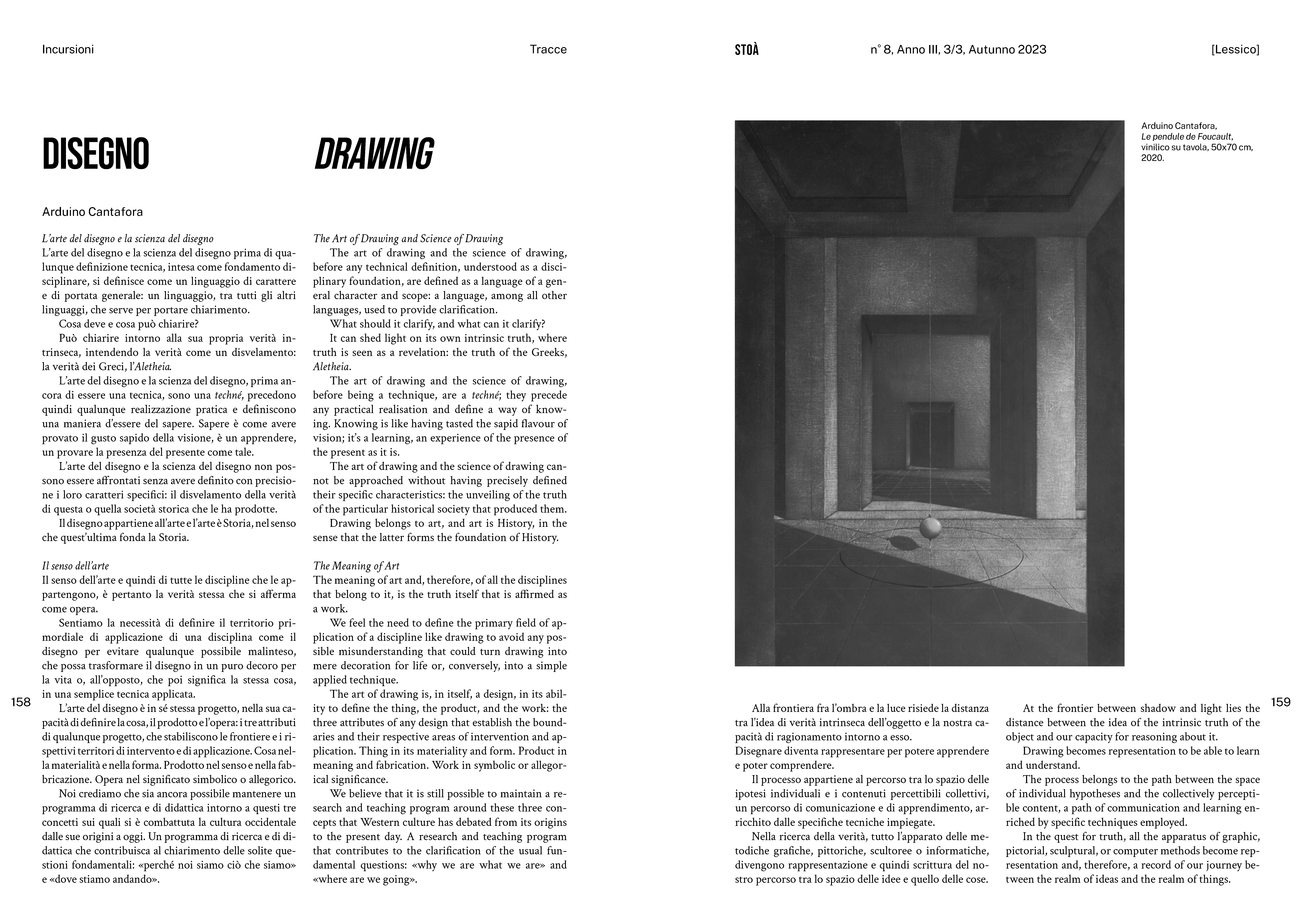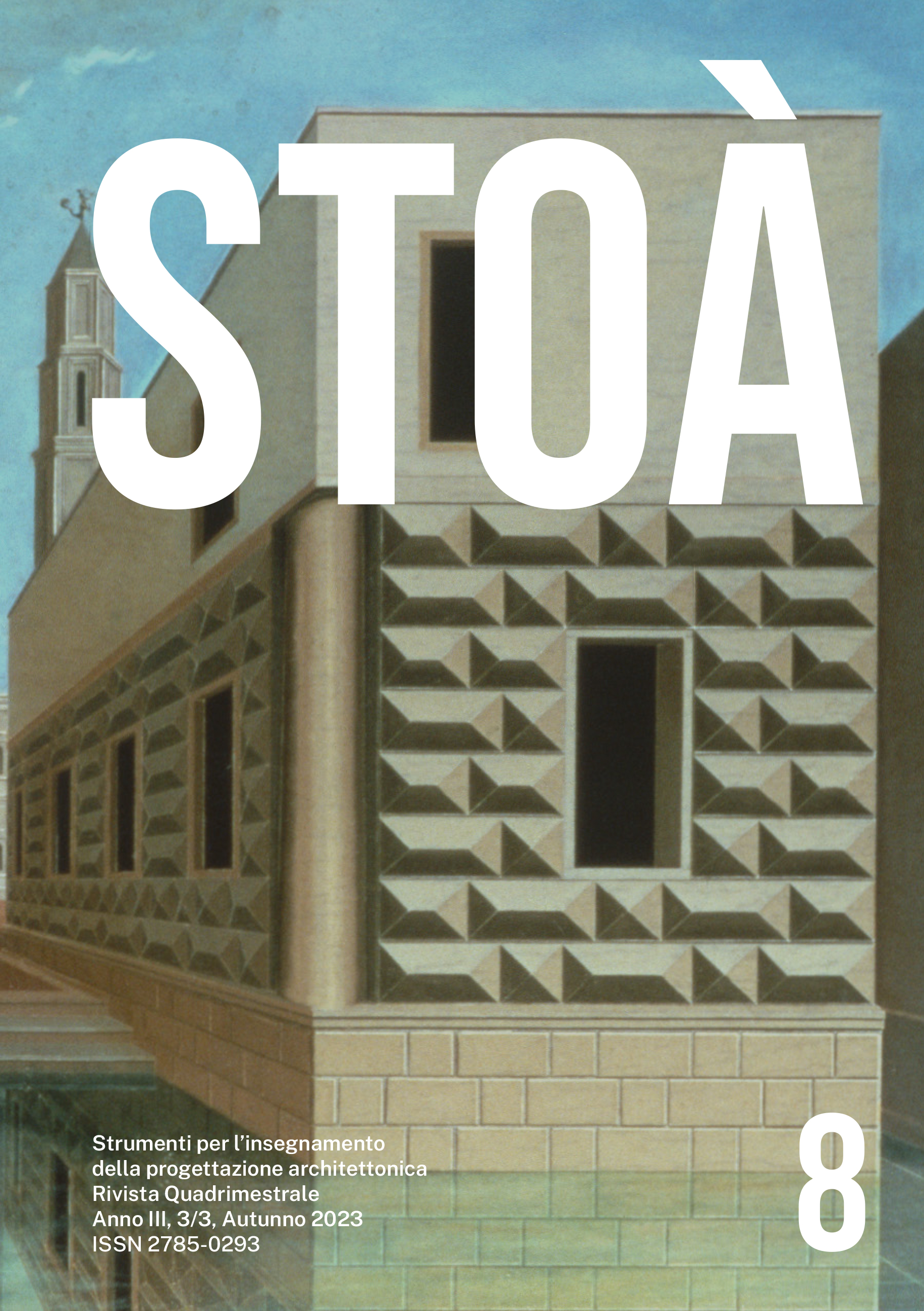︎︎︎ Issue 08 Abstracts
STOÀ 08 [Lessico]
Anno III, 3/3, Autunno 2023
ISSN 2785-0293
ISBN 978-88-32072-26-6
︎︎︎Issues
︎︎︎Get a copy
Adrian Forty
Of Words and Buildings / Parole e edifici / Posizioni / pp. 14-19
Il saggio descrive la costruzione del volume Parole e Edifici, noto scritto dello storico Adrian Forty, partendo dalle motivazioni e dalla scelta di un determinato posizionamento culturale che hanno portato l’autore a definire l’abbecedario di termini che compongono il volume, a partire da una delle caratteristiche peculiari riconducibile all’architettura moderna: non proporre una nuova maniera di costruire, ma anche e soprattutto aver proposto e alimentato un nuovo modo di discutere di architettura.
The essay describes the construction of the volume Words and Buildings, a well-known work by the historian Adrian Forty, starting from the motivations and the choice of a specific cultural positioning that led the author to define the alphabet of terms that make up the volume. This choice stems from one of the peculiar characteristics of modern architecture: not only to propose a new way of building, but also, and above all, to propose and promote a new way of discussing architecture.
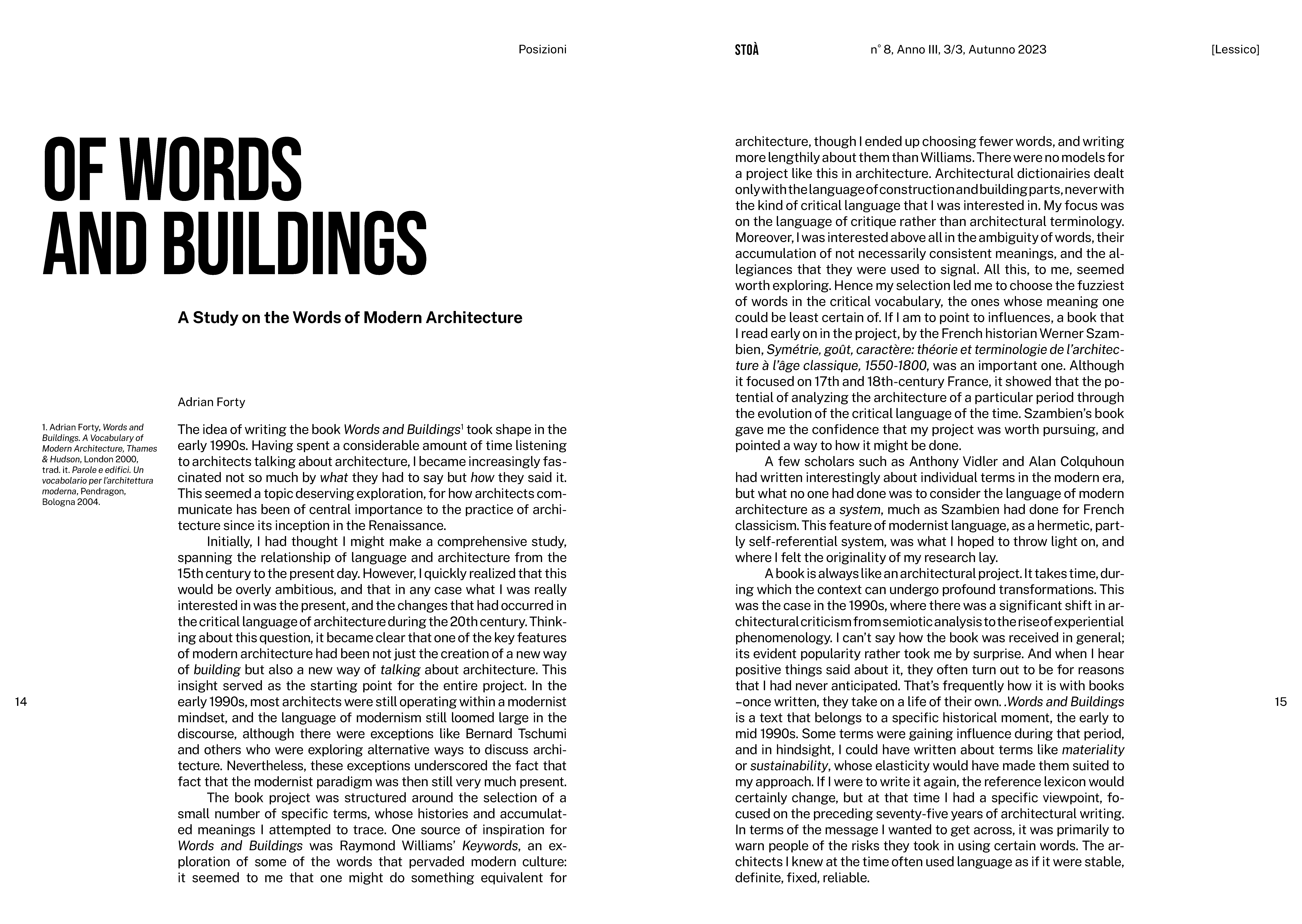

Reinier de Graaf, Fabrizio Ballabio
Architecture’s Doublespeak / L’architettura non è un verbo / Posizioni / pp. 20-33
L’intervista a Reinier de Graaf – partner di OMA/AMO – condotta da Fabrizio Ballabio discute i temi del recente libroarchitect, verb, che analizza le parole che hanno saturato il dibattito sulla produzione dell’ambiente costruito negli ultimi vent’anni, per lo più in senso negativo, discutendo le logiche di produzione dell’architettura individuando una trattoria possibile da seguire oggi per restituire all’architettura la sua capacità di immaginazione.
The interview with Reinier de Graaf, partner at OMA/AMO, conducted by Fabrizio Ballabio, discusses the themes of the recent book architect, verb, which analyses the words that have saturated the debate on the production of the built environment over the last twenty years, mostly in a negative sense. He discusses the logics of architectural production and identifies a possible path to follow today in order to restore architecture's capacity for imagination.


Jacques Gubler
The Industrial Revolution. An Attempt at Visualisation / La Rivoluzione industriale. Tentativo di visualizzazione / Ideario / pp. 34-51, 175
L’insieme dei rapporti intercorrenti tra tecnica, forma, carattere e registro linguistico denotano da sempre, dell’architettura, una sequenza di interconnessioni non sempre evidente e non sempre emblematiche delle diverse epoche. Entrando in media res del linguaggio dell’architettura e della tecnica attraverso la storia, in questo racconto per immagini, Jacques Gubler, da storico dell’arte, legge l’architettura attraverso un metodo analogico-interpretativo che, senza mai parlare di lessico in modo esplicito, adopera il lessico stesso per costruire un ragionamento attorno alle relazioni che stanno nell’architettura alle varie scale.
The network of relationships between technology, form, character and language in architecture has always revealed a series of interconnections that are not always obvious and not always emblematic of the different historical periods. In this visual essay, Jacques Gubler, an art historian, ventures into the heart of architectural language and technology throughout history, reading architecture with an analogue and interpretive method. Without explicitly discussing the lexicon, he uses the lexicon itself to construct a discourse on the relationships inherent in architecture at different scales.


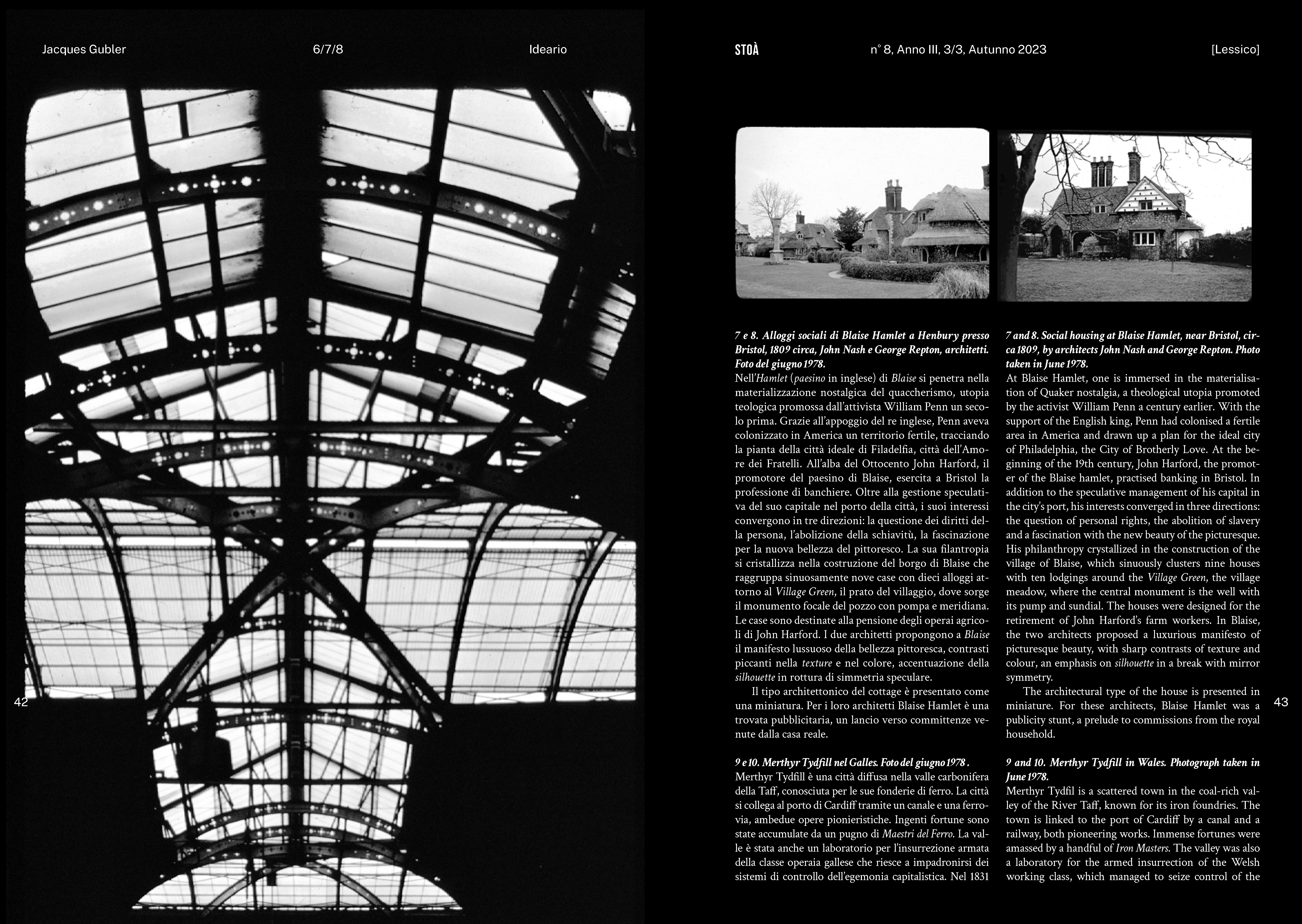
Matthew Blunderfield
Field Work / Lavoro sul campo / Corrispondenze / pp. 52-61
Il saggio intende discutere la relazione tra linguaggio e architettura, tra parole e cose, descrivendo come il lavoro di intervistatore informa il farsi dell'architettura. Attraverso dialoghi e interviste, i tentativi di tradurre l’architettura in termini esprimibili e intelligibili lasciano emergere questioni e rivelazioni: la loro comprensione avviene attraverso un’attenta pratica di registrazione sul campo espanso dell’architettura.
This essay explores the tensions between language and architecture, between words and things, describing how the work as an interviewer informs the making of architecture. The text discusses problems and revelations that occur when attempting to translate architecture into effable terms through the recording of its expanded field through field work.


Lorenzo Chironi, Stefano Passamonti
Il lessico radicale di Christ & Gantenbein / The Radical Lexicon of Christ & Gantenbein / Rapporti / pp. 62-75
L’articolo offre una interpretazione di una serie di concetti teorici e modalità sottesi all’uso ricorrente di alcuni specifici vocaboli nelle pratiche d’insegnamento degli architetti e docenti Emanuel Christ e Christoph Gantenbein. Gli architetti elvetici si distinguono nel panorama accademico europeo per il respiro degli indirizzi di ricerca, per la radicalità della traiettoria didattica e per la nettezza delle questioni intorno alle quali sviluppano i propri corsi, incentrati sulla costruzione di un discorso critico e sul concetto di typologytransfer.
The article provides an interpretation of a series of theoretical concepts and underlying methods in the recurrent use of specific vocabulary in the teaching practices of architects and professors Emanuel Christ and Christoph Gantenbein. The Swiss architects stand out in the European academic landscape for the breadth of their research directions, the radicalism of their didactic trajectory, and the clarity of the issues around which they develop their courses, focused on the construction of a critical discourse and the concept of typology transfer.


Martina Landsberger
Il teatro dell’architettura / The Theater of Architecture / Rapporti / pp. 76-87
Che cosa è un teatro? Facendo riferimento al suo significato etimologico il teatro è il luogo del pubblico spettacolo. E cosa c’è di più pubblico, o forse meglio, di collettivo, se non l’architettura attraverso cui si costruiscono i luoghi della nostra vita? Il contributo intende partire da queste considerazioni per indagare il concetto del rappresentare e del sentirsi rappresentato, intesi quali azioni necessarie – in particolar modo, credo, in ambito didattico – attraverso cui attribuire significato e riconoscibilità al progetto di architettura.
What is a theater? Referring to its etymological meaning, the theater is the place of public spectacle. And what is more public, or perhaps better, more collective, than architecture itself, through which the places of our lives are constructed? This contribution intends to start from these considerations to investigate the concept of representation and feeling represented, understood as necessary actions – especially, I believe, in an educational context – through which to attribute meaning and recognizability to the architectural project.


VOLUPTAS. François Charbonnet, Patrick Heiz, Marina Montresor
Short-Cuts on Portraits and Agents / Short-Cuts on Portraits and Agents / Rapporti / pp. 88-97
Portrait is the name of a series of design studios taught by MADE IN (Charbonnet, Heiz) at the ETH Zurich and the Accademia di Architettura di Mendrisio from 2011 to 2015. The common denominator of the series is the emphasis on the productive tension that the students question with their projects. with their projects: as a pedagogical method, Portraitdeparted from words and images, inviting students to define a trajectory that would constitute a brief through narrative, and then illustrate it through a montage of sources. The final projects evade easy classifications of size, programme, material. What counts most is the surprising proximity of references, narratives and sources, the combination of which produces a result that is incommensurably greater than the sum of its than the sum of its parts.
Portrait è il nome della serie di atelier di progettazione che MADE IN (Charbonnet, Heiz) ha insegnato presso l’ETH di Zurigo e l’Accademia di Architettura di Mendrisio dal 2011 al 2015. Il denominatore comune che attraversa le serie è l’accento sulla tensione produttiva che gli studenti avrebbero messo in discussione con i loro progetti. Come metodo pedagogico, Portrait parte da parole e immagini per invitare gli studenti a definire una traiettoria che, attraverso una narrazione, avrebbe costituito un programma, per poi illustrarlo attraverso un montaggio critico di riferimenti e fonti. I progetti finali evadono i criteri convenzionali di scala, programma, materialità con i quali si definisce normalmente un progetto architettonico. Nei progetti di Portrait quello che conta di più sono le sorprendenti prossimità di riferimenti, narrazione e fonti, la cui combinazione genera un risultato incommensurabilmente più ampio della somma delle sue parti.
![]()
![]()
Marco Moro
Types & Trays. Nel linguaggio materiale di Harvard GSD / Types & Trays. Into the Material Language of Harvard GSD / Corrispondenze / pp. 98-113
Nel 2022, Harvard University celebra i cinquant’anni dall’inaugurazione della Gund Hall. Edificio iconico della Graduate School of Design sotto il cui unico tetto si erano finalmente radunati tutti gli insegnamenti nel campo del progetto architettonico. In prossimità della fine delle celebrazioni, una fortunata coincidenza vede Rafael Moneo in visita negli Stati Uniti proprio in quei giorni. Così, grazie all’assetto della lobby collocata al piano terra della Francis Loeb Library, il direttore del Dipartimento di Architettura di Harvard GSD dal 1985 al 1990 ha potuto offrire una lezione informale ma piuttosto densa sui temi che hanno contraddistinto tanto la sua pratica professionale come quella di educatore. Infatti, mentre la Gund Hall aspirava ad affermarsi come edificio-tipo in grado di stimolare una rivoluzione pedagogica nel modo di insegnare e apprendere in forma collettiva dentro un unico grande spazio terrazzato, Moneo guardava al typecome essenza dell’architettura riconsiderando i connotati materiali di uno dei concetti più elusivi nella formazione di un architetto.
In 2022, Harvard University celebrated the fiftieth anniversary of the inauguration of Gund Hall. This iconic building of the Graduate School of Design finally brought together under one roof all teachings in the field of architectural design. As the celebrations neared their end, a fortunate coincidence saw Rafael Moneo visiting the United States during those days. Thus, thanks to the arrangement of the lobby located on the ground floor of the Francis Loeb Library, the director of the Department of Architecture at Harvard GSD from 1985 to 1990 was able to offer an informal yet substantial lecture on the themes that characterized both his professional practice and his role as an educator. Indeed, while Gund Hall aspired to establish itself as a building type capable of stimulating a pedagogical revolution in the way of teaching and learning collectively within a single large terraced space, Moneo looked at the type as the essence of architecture, reconsidering the material connotations of one of the most elusive concepts in the formation of an architect.
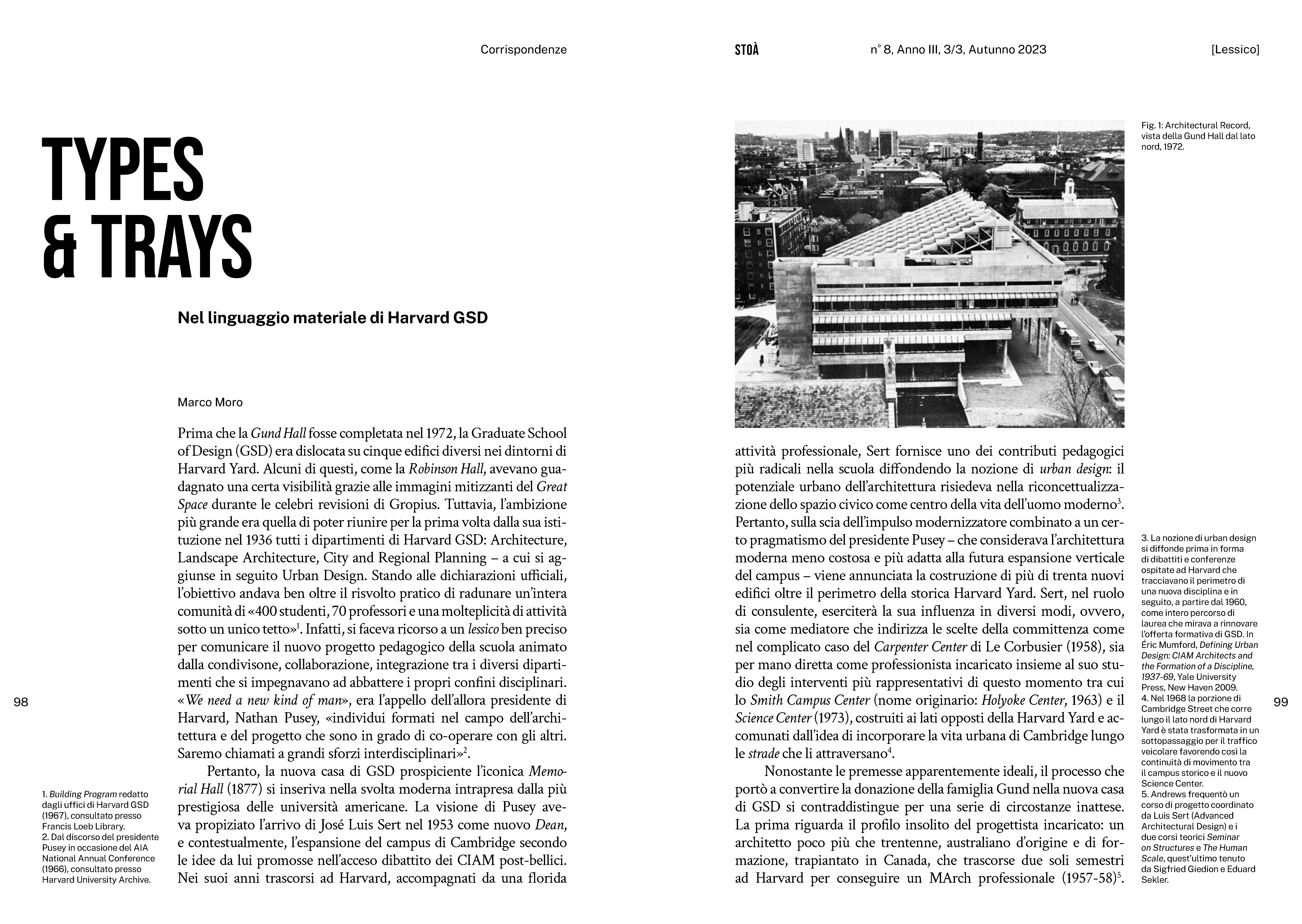

João Paupério, Maria Rebelo
An Abecedarium for Thinking / Un abbecedario per pensare / Rapporti / pp. 114-125
Il saggio intende discutere la relazione tra linguaggio e architettura, tra parole e cose, descrivendo come il lavoro di intervistatore informa il farsi dell'architettura. Attraverso dialoghi e interviste, i tentativi di tradurre l’architettura in termini esprimibili e intelligibili lasciano emergere questioni e rivelazioni: la loro comprensione avviene attraverso un’attenta pratica di registrazione sul campo “espanso” dell’architettura.
This essay explores the tensions between language and architecture, between words and things, describing how the work as an interviewer informs the making of architecture. The text discusses problems and revelations that occur when attempting to translate architecture into effable terms through the recording of its expanded field through field work.


Federico Perugini
Text as a Building / Text as a Building / Rapporti / pp. 126-139
Il saggio intende discutere la relazione tra linguaggio e architettura, tra parole e cose, descrivendo come il lavoro di intervistatore informa il farsi dell'architettura. Attraverso dialoghi e interviste, i tentativi di tradurre l’architettura in termini esprimibili e intelligibili lasciano emergere questioni e rivelazioni: la loro comprensione avviene attraverso un’attenta pratica di registrazione sul campo “espanso” dell’architettura.
This essay explores the tensions between language and architecture, between words and things, describing how the work as an interviewer informs the making of architecture. The text discusses problems and revelations that occur when attempting to translate architecture into effable terms through the recording of its expanded field through field work.


Renato Rizzi, Irina Davidovici, Matteo Vegetti, Armando Dal Fabbro, Arduino Cantafora, Éric Lapierre, Aslı Çiçek, Mark Pimlott, Renato De Fusco, Tullia Iori, Fernando Espuelas, a cura di Fabrizio Ballabio e Carlo Gandolfi
Incursioni / Forays / Tracce / pp. 140-173
La sezione Tracce di Stoà 8 cerca di ridefinire una serie di parole chiave nell’ambito dell’insegnamento della disciplina inquadrandone l’importanza storica all’interno di un ragionamento sulla contemporaneità. Si tratta di termini il cui utilizzo consolidato attraverso i secoli ha fatto si che rimanessero immuni al revisionismo terminologico al quale il lessico dell’architettura è stato sottoposto negli ultimi decenni: Architettura, Archivio, Città, Composizione, Disegno, Forma, Modello, Ragione, Scenografia, Sito, Storia, Struttura, Vuoto. La definizione di ognuno di essi è stata affidata ad una specifica autrice o autore: ricercatori e docenti provenienti dal mondo dell’università e dalla professione la cui expertise rispetto a un determinato tema potesse assicurarci un livello profondo di analisi nello spazio breve attribuito a una singola voce.
The section Tracce of Stoà 8 attempts to redefine the meaning of a series of key words in current architectural pedagogy, framing their historical meaning within an argument rooted in the present moment. Words whose consolidated use over the centuries has meant that they have resisted the terminological revisionism from which much of the architectural vocabulary has suffered in recent years: Architecture, Archive, City, Composition, Design, Form, History, Model, Reason, Scenography, Site, Structure, Void. The definition of these terms has been entrusted to a specific group of authors: researchers and teachers, both practitioners and academics, whose expertise could guarantee a deep level of analysis in the space of a short text.


